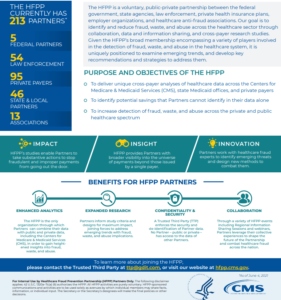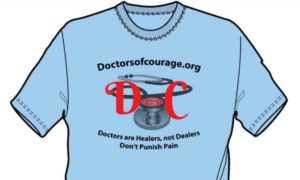I want to introduce to you an organization that is new to me, but is playing an important part in the attacks on doctors and pain patients. This organization is the Healthcare Fraud Prevention Partnership (HFPP).
HFPP was established in 2012 as a public (government insurance-CMS)-private (private insurance companies) partnership with approximately 20 Partners, to share data and information. Today it has grown to 216 Partners, including
- Federal Partners including DOD, CMS, HHS, Dept of Labor, Federal Employee’s Compensation, and VA.
- Law Enforcement including US DOJ Criminal Division, FBI, OIG, FDA, Postal Service, State Attorney General offices, State police
- Private Insurance Payers and Companies including Aetna, Anthem, Blue Cross Blue Shield, Cardinal, Cigna, CVS, Express Scripts, Humana, Kaiser Permanente, UnitedHealthcare, and more
- State & Local Partners including state medical boards, Departments of Human Services.
- Associations and Insurance Companies
HFPP’s Goal
HFPP’s primary goal is stated as combatting healthcare fraud, waste, and abuse. Here is a picture of their fact sheet:

They had a meeting in October, 2016 to identify, address, and minimize opioid prescription abuse and inappropriate payments while supposedly ensuring access to medically necessary therapies. Bottom line, however, is to identify and target physicians not compliant with the decrease in opioid prescribing.
Additional discussions included enforcement of Prescription Drug Monitoring Program (PDMP) mandates and breakthrough pain treatments without a cancer diagnosis. HFPP Partners provided real life examples of pharmacy “bad actors,” pill mills, emerging lab schemes, drug waste/inventory, and third party billing.
An interesting segment was the presentation by DOJ representatives on how private insurances can prosecute doctors criminally in collusion with the federal government. The statutes offered were:
- 18 U.S. Code § 1347- Health Care Fraud:
- 18 U.S. Code § 24 – Definitions: Makes “federal health care offense” apply to private insurance.
- 18 U.S. Code § 669 – Theft or embezzlement in connection with health care:
- 18 U.S. Code § 1035 – False statements relating to health care matters:
- 18 U.S. Code § 1518 – Obstruction of criminal investigations of health care offenses:
In their opioids session, CMS emphasized the need to identify those prescribers who are not doing the right thing.
HFPP Strategies Identified
A goal of the afternoon session was to obtain input for the White Paper Statements and Strategies to address inappropriate prescribing or dispensing of opioids. The key strategies identified were:
- Manage formularies to control for abusive practices and reduce barriers to safer alternatives
- Engage with providers, and educate them about the risks of prescribing opioids, the best practices in providing care and managing treatment, and the value of cross-provider communication
- Engage with patients to inform them about the safe drug use and assess risk factors for opioid abuse
- Encourage use of safe alternatives to opioids such as non-opioid analgesics and nonpharmacological treatments
- Provide access to opioid abuse treatment interventions, such as Methadone or Buprenorphine regimens, inpatient or outpatient therapies, etc.
- Improve access to, and information about, Naloxone and Narcan
- Build coalitions focused on identifying and implementing solutions
- Improve data sharing and utilization (e.g. encourage participation in and use of prescription drug monitoring programs’ databases, conducting utilization reviews)
- Improve prescribing systems and monitoring processes (e.g. require the use of electronic prescribing, implementing point of sale edits, limiting prescribing privileges when needed)
- Implement and streamline patient review, case management and restriction programs (aka “Lock-in” programs)
Article in 2017 by Pain News Network
Pat Anson exposed this government-insurance collusion in an October, 2017 article, but the importance of the information did not reach his audience. It is important that everyone who reads this understands that this collusion to target practitioners treating pain—in order to save insurance companies money—is the downfall of the medical profession if it is allowed to progress. It is now 5 years since this meeting took place, and we can see the result with increased attacks on compassionate physicians treating pain with opioids, and the marking of chronic pain patients using data analysis and data sharing. Understand—opioids are safe when prescribed by a physician. They become unsafe when prescription guidelines come from non-medical, government entities or private insurance companies only interested in the bottom $$$ line.
Part II will be the summary of the White Paper that was produced as a result of this collaboration.
Linda Cheek is a teacher and disenfranchised medical doctor, turned activist, author, and speaker. A victim of prosecutorial misconduct and outright law-breaking of the government agencies DEA, DHHS, and DOJ, she hopes to be a part of exonerating all doctors illegally attacked through the Controlled Substance Act. She holds the key to success, as she can offset the government propaganda that drugs cause addiction with the truth: The REAL Cause of Drug Abuse.
Get a free gift to learn how the government is breaking the law to attack your doctor: Click here to get my free gift


Money has been put before people. The cartels are loving it, laughing all the way to the bank. My quality of life has been robbed from me because I can’t recieve the treatment of educated physicians. We are being discriminated against. There’s No 1 size that fits all! Is a pain patient genocide. Pain patients going to the streets for pain relief or committing suicide. Chronic pain can happen to anyone in an instance. Welcome to your new life of a lifetime of pain. The 2016 CDC guidelines illegally written in secret, in silence and without any input from pain specialists or chronic pain patients. Those guidelines have been weaponized to prosecute doctors who treat pain, weather it’s cancer, hospice, autoimmune, surgical complications, sickle cell patients and accidents. People need to wake up and know what atrocities are occurring. The inhumane suffering continues 5+ years. I shall never want others to have to suffer 24/7, day after day, and unfortunately year after year. What’s happening is cruel, inhumane and unethical. Drs are educated and take an oath to do no harm. The American Medical Association has said that the CDC has harmed pain patients. Never in my lifetime did I think healthcare wasn’t for me. Insulin can kill, no one is going after diabetics. Tylenol is the #1 poison for poison control. These atrocities against vulnerable pain patients. This shouldn’t be happening, especially in America.
I see you are following the rabbit trail instead of focusing on the elephant in the room. If you want to see change, get off the CDC guidelines and learn what I teach–the REAL cause of drug abuse. It is the propaganda that drugs cause addiction that is causing the problem. The CDC guidelines don’t matter, and by using that argument, you will soon see opioids disappear from the treatment plan entirely.
I agree with you Linda about those still trying to get the CDC Guidelines changed. The new projected guidelines actually are worse for those in chronic pain. One might argue that all the complaining and finger pointing at the guidelines, the damage it may have had has actually driven those crafting and updating the guidelines has had a “we will show you” response. I have to say I am surprised some advocates are still trying to effect change with regard to the guidelines. Its been five years now, so many letters, reports all showing clearly the guidelines are hurting those of us who need pain medication so we can function. They need to regroup and try a different approach, one that might actually work. Why was the CDC tasked with the guidelines? Thats an FDA job. Why was the CDC tasked with developing a daily MME? That is an FDA thing since they approve those meds. Doses are unique to each patient and the skill of their physician. When it comes to pain management, the CDC never should have been invilved in writing the guidelines. Who tasked them with this job that is affecting millions of pain patients? Who and why??
.
Sorry, I can’t answer your questions about the reasons behind the CDC guidelines because, as you know, I don’t put any weight at all in following that rabbit trail. But the action that needs to be taken is to recognize that the use of the Controlled Substance Act against doctors is not legitimate use of that law, and get it repealed. That is our mission, and I hope you join us.